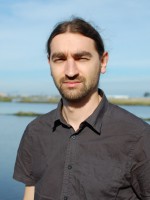resumo
High-temperature characterization of oxygen-deficient Sr-rich (La1-xSrx)(2)NiO4-delta (x = 0.5-0.8) solid solutions under mildly reducing conditions with p(O-2) approximate to 5x10(-5) atm was performed by employing structural and thermal analysis, TEM, and electrical conductivity measurements. Oxygen losses from the crystal lattice on reduction were found to result in a reversible transition from the tetragonal (I4/mmm) to the orthorhombic (Immm) structure and shrinkage of the crystal lattice for the compositions with x > 0.5. TEM and thermogravimetric analysis evidenced slow kinetics of the structural transition. The increase in oxygen deficiency under reducing conditions is accompanied by localization of the electronic charge carriers, a drop of the p-type electronic conductivity, and a transition from metallic-like to semiconducting behavior. The extent of changes in oxygen nonstoichiometry, unit--cell dimensions, average Ni oxidation state, electron-hole concentration, and electronic conductivity on reduction is interrelated with the strontium content. The results suggest that the electrical conductivity of (La1-xSrx)(2)NiO4-delta ceramics depends mainly on the average Ni oxidation state.
palavras-chave
ELECTROCHEMICAL PROPERTIES; CRYSTAL-CHEMISTRY; OXIDATION-STATE; MIXED-OXIDE; SOL-GEL; LA2-XSRXNIO4; DEFECT; NONSTOICHIOMETRY; CONDUCTIVITY; TRANSPORT
categoria
Chemistry
autores
Kravchenko, E; Neagu, A; Zakharchuk, K; Grins, J; Svensson, G; Pankov, V; Yaremchenko, AA
nossos autores
Projectos
agradecimentos
This work was supported by the FCT, Portugal [project IF/01072/2013/CP1162/CT0001 and project CICECO-Aveiro Institute of Materials POCI-01-0145-FEDER-007679 (FCT ref. UID/CTM/50011/2013), financed by national funds through the FCT/MEC and when appropriate co-financed by FEDER under the PT2020 Partnership Agreement]. E. K. would like to acknowledge the doctoral grant by the Belarusian State University and the Visby Programme scholarship by the Swedish Institute. The Knut and Alice Wallenberg Foundation is acknowledged for funding the electron microscopy facilities at Stockholm University.



